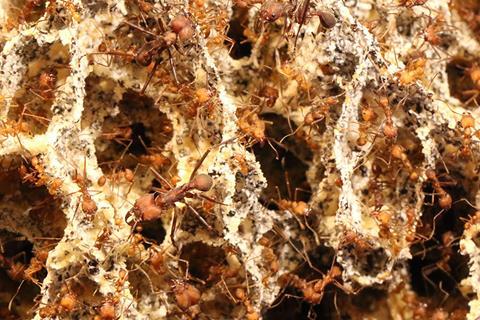While our human ancestors began domesticating food crops around 10,000 years ago, a lineage of ants called the ‘attines’ became fungus farmers 60 million years earlier.

The attine ants and their fungal crop mutually depend on each other for survival. The ants plant, protect, provision, and cultivate their fungus, which then provides the ants with a stable food supply.
READ MORE: Asteroid that doomed dinosaurs created fungus farming among ants
READ MORE: Sneaky pathogenic fungi hide from ants by dialling down their natural signals
Leafcutter ants have the most advanced attine farming systems and have proven resilient across over 15 million years of climate change and now they are the dominant herbivores (and often crop pests) across diverse habitats from Argentina to northern Texas.
Sophisticated farming systems
Since leafcutter ant farming systems were discovered 150 years ago, scientists have worked understand how ants evolved such sophisticated farming systems without the benefits of technology or culture that fueled the rise of human farming systems.
Moreover, the fungal crop of leafcutter ants is passed from generation to generation like human crops, exhibits signatures of domestication analogous to those that distinguish modern supermarket corn cobs from small inedible seeds produced by its wild ancestor—an unassuming grass. For example, the leafcutter ant fungus produces swollen nutritional reward structures that are otherwise unique in the fungal kingdom. Until now, the key genomic adaptations fueling these domestication processes have remained poorly understood.
A groundbreaking study of these domestication processes has just been published in the journal Molecular Biology and Evolution from the research group of Associate Professor Jonathan Shik in the Department of Biology at the University of Copenhagen (UCPH) and the Smithsonian Tropical Research Institute. The research, funded by an ERC Starting Grant and a Villum Experiment Grant, was led by Assistant Professor Caio Leal-Dutra from the Shik group and harnessed cutting-edge genome sequencing approaches to decode the genetic building blocks that comprise Leucoagaricus gongylophorus, the fungus farmed by the leafcutter ants. By deciphering these genes and comparing them to those contained in other fungi, the researchers were able to determine which parts of the fungal genome have changed as a result of millions of years under ant cultivation.
Genetic clues
“We found important genetic clues that show how the fungus has adapted to life with the ants,” explains the lead author Leal-Dutra. “Some of these genetic changes help the fungus break down plant material and accumulate nutrients, making it a perfect partner for the ants.” The research found new groups of genes that help the fungus defend against diseases and optimize its partnership with the ants, ensuring the stability and productivity of their farming system across diverse habitats.
The team also discovered many mobile genetic elements, or “jumping genes,” in the fungus’ DNA. These elements can quickly change the genetic makeup of the fungus, allowing it to adapt to challenges and rapidly evolve in response to environmental changes. These findings suggest that natural selection has shaped the fungus to thrive in its cultivated state, while maintaining a delicate balance with its ant farmers over millennia.
Scientific and societal impacts
This research not only highlights the remarkable evolutionary success of fungus-farming ants but also has broader implications for understanding how natural selection can drive the domestication of crops. By examining the genomic adaptations of these fungi, scientists can gain learn how farming systems can evolve through ecological interactions rather than human intervention.
“Understanding the long-term resilience of ant-farming systems could inspire new ways to think about sustainable agriculture,” says senior author Shik. “Although we can’t yet transfer ant-farming methods to human agriculture, studying these systems can reveal how genetic change can help farmers balance yield and environmental stability.”
As humans face increasing challenges in modern agriculture, particularly regarding climate change and crop resilience, the evolutionary solutions revealed in this study offer exciting avenues for future research in agricultural sciences.







No comments yet